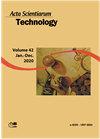Validation of mathematical models as a tool for prediction of α-amylase production by Coprinus comatus in a low-cost culture medium
IF 0.6
4区 综合性期刊
Q3 MULTIDISCIPLINARY SCIENCES
引用次数: 0
Abstract
Studying new microbial sources and evaluating the growth kinetics behavior to predict large-scale production become essential. Besides, research with low-cost culture media has gained interest due to the need to decrease enzyme production costs. The literature concerning the use of macromycetes as a source of amylases, and applying mathematical models to predict their behavior is scarce. In this study, four growth kinetics in different compositions of culture media were carried out: two of them using different concentrations of Low-Grade Flour (LGF), one wheat mill by-product and two synthetic ones. In the kinetics mathematical models were used to evaluate the bioprocesses and their scaling feasibility. Mathematical models, such as modified Logistic, modified Gompertz, Baranyi, and Roberts, and modified Luedeking-Piret, were applied to predict mycelial growth, enzyme production, and substrate consumption. The results showed the model’s capability to predict mycelial growth (biomass) and substrate consumption (starch concentration). On the other hand, the mathematical models efficiently describe only the maximum enzymatic activity (α-amylase), not the process's other parameters, because of the complexity and diversity of biomolecules synthesized by Coprinus comatus. The wheat mill by-product was efficient as an ingredient in the culture media composition. Furthermore, it was concluded that B2 formulation (culture medium with 48.5 g/L of LGF) is the batch with the highest potential for the α-amylase production from C. comatus and the expansion of this process on an industrial scale. This study is important and valid for the scientific community since modeling studies for macromycetes are scarce in the literature.数学模型在低成本培养基中预测鸡鸡α-淀粉酶产量的验证
研究新的微生物来源和评估其生长动力学行为对预测大规模生产至关重要。此外,由于需要降低酶的生产成本,低成本培养基的研究也引起了人们的兴趣。关于利用大型菌体作为淀粉酶的来源,并应用数学模型来预测其行为的文献很少。本试验研究了4种培养基在不同培养基组成下的生长动力学,其中2种培养基使用不同浓度的低品质面粉(LGF), 1种培养基使用小麦磨副产物,2种培养基使用合成培养基。在动力学方面,采用数学模型来评价生物过程及其规模化可行性。数学模型,如改良Logistic、改良Gompertz、Baranyi和Roberts、改良Luedeking-Piret,被用于预测菌丝生长、酶产量和底物消耗。结果表明,该模型能够预测菌丝生长(生物量)和底物消耗(淀粉浓度)。另一方面,由于鸡腿菇合成的生物分子的复杂性和多样性,数学模型只能有效地描述最大酶活性(α-淀粉酶),而不能描述过程的其他参数。小麦碾磨副产物可作为培养基组成的有效成分。结果表明,B2配方(含48.5 g/L LGF的培养基)是产α-淀粉酶的最佳配方,且该工艺在工业规模上的推广潜力最大。这项研究对科学界来说是重要和有效的,因为文献中对大型真菌的建模研究很少。
本文章由计算机程序翻译,如有差异,请以英文原文为准。
求助全文
约1分钟内获得全文
求助全文
来源期刊

Acta Scientiarum-technology
综合性期刊-综合性期刊
CiteScore
1.40
自引率
12.50%
发文量
60
审稿时长
6-12 weeks
期刊介绍:
The journal publishes original articles in all areas of Technology, including: Engineerings, Physics, Chemistry, Mathematics, Statistics, Geosciences and Computation Sciences.
To establish the public inscription of knowledge and its preservation; To publish results of research comprising ideas and new scientific suggestions; To publicize worldwide information and knowledge produced by the scientific community; To speech the process of scientific communication in Technology.
 求助内容:
求助内容: 应助结果提醒方式:
应助结果提醒方式:


